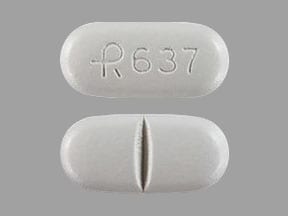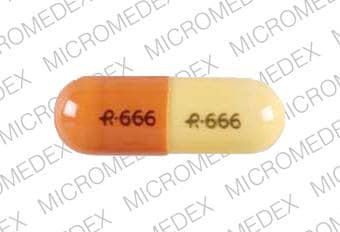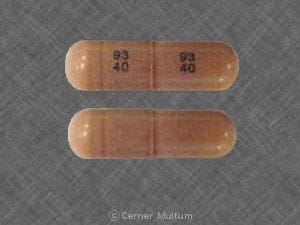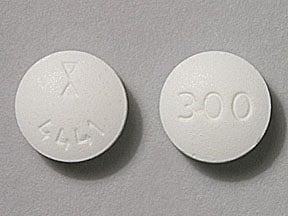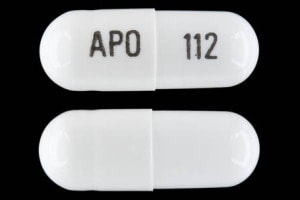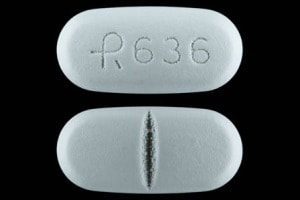Dosage Forms
Excipient information presented when available (limited, particularly for generics); consult specific product labeling.
Capsule, Oral:
Neurontin: 100 mg, 300 mg, 400 mg
Generic: 100 mg, 300 mg, 400 mg
Miscellaneous, Oral:
Gralise Starter: 300 & 600 mg (78 ea) [contains soybean lecithin]
Solution, Oral:
Neurontin: 250 mg/5 mL (470 mL); 250 mg/5 mL (470 mL) [strawberry anise flavor]
Generic: 250 mg/5 mL (473 mL); 300 mg/6 mL (6 mL); 250 mg/5 mL (5 mL, 6 mL, 470 mL)
Tablet, Oral:
Gralise: 300 mg [contains soybean lecithin]
Gralise: 600 mg
Neurontin: 600 mg, 800 mg [scored]
Generic: 600 mg, 800 mg
Pharmacology
Mechanism of Action
Gabapentin is structurally related to GABA. However, it does not bind to GABAA or GABAB receptors, and it does not appear to influence synthesis or uptake of GABA. High affinity gabapentin binding sites have been located throughout the brain; these sites correspond to the presence of voltage-gated calcium channels specifically possessing the alpha-2-delta-1 subunit. This channel appears to be located presynaptically, and may modulate the release of excitatory neurotransmitters which participate in epileptogenesis and nociception.
Pharmacokinetics/Pharmacodynamics
Absorption
Variable, from proximal small bowel by L-amino transport system; saturable process; dose-dependent
Distribution
Vd: 58 ± 6 L; CSF concentrations are ~20% of plasma concentrations
Metabolism
Not metabolized
Excretion
Proportional to renal function; urine (as unchanged drug)
Clearance: Apparent oral clearance is directly proportional to CrCl: Clearance in infants is highly variable; oral clearance (per kg) in children <5 years of age is higher than in children ≥5 years of age
Time to Peak
Immediate release: Infants 1 month to Children 12 years: 2 to 3 hours; Adults: 2 to 4 hours; Extended release: 8 hours
Half-Life Elimination
Infants 1 month to Children 12 years: 4.7 hours
Adults, normal: 5 to 7 hours; increased half-life with decreased renal function; anuric adult patients: 132 hours; adults during hemodialysis: 3.8 hours
Protein Binding
<3%
Use in Specific Populations
Special Populations: Renal Function Impairment
In CrCl <30 mL/minute, half-life is approximately 52 hours (immediate release). In moderate and severe renal impairment, Cl was decreased to 3 and 1 L/hour, respectively, compared with 5 to 7 L/hour in nonrenal impairment patients (ER).
Use: Labeled Indications
Postherpetic neuralgia: Management of postherpetic neuralgia (PHN) in adults.
Seizures, focal (partial) onset (immediate release only): As adjunctive therapy in the treatment of focal (partial) seizures with and without secondary generalization in adults and pediatric patients 3 years of age and older with epilepsy.
Use: Off Label
Alcohol use disorder, moderate to severe (alternative agent)byes
Data from randomized, double-blind, placebo-controlled studies support the use of gabapentin in the maintenance of abstinence in patients with alcohol use disorder Brower 2008, Furieri 2007, Mason 2014.
Based on the American Psychiatric Association (APA) guidelines for the pharmacological treatment of patients with alcohol use disorder, gabapentin is suggested for patients with alcohol use disorder (moderate to severe) who want to decrease or abstain from use of alcohol and either prefer gabapentin or are unable to tolerate or are unresponsive to naltrexone and acamprosate APA [Reus 2018]. Based on the VA/DoD clinical practice guideline for the management of substance use disorders, gabapentin given for moderate to severe alcohol use disorder is effective and suggested when first-line pharmacotherapy is contraindicated or ineffective VA/DoD 2015.
Alcohol withdrawal, mild (alternative agent)byes
Data from a randomized, double-blind, active-controlled study support the use of gabapentin in the outpatient treatment of mild alcohol withdrawal Myrick 2009. Similarly, a high heterogeneity meta-analysis that included only a limited number of randomized, controlled trials support the use of gabapentin in the treatment of alcohol withdrawal Ahmed 2019.
Based on the VA/DoD clinical practice guideline for the management of substance use disorders, gabapentin given for mild alcohol withdrawal is suggested as an alternative agent when the risk of benzodiazepines outweigh the benefits (eg, inadequate monitoring available, abuse liability, contraindication, adverse reaction) VA/DoD 2015.
Cough, chronic refractory (alternative agent)cyes
Data from a small, randomized, double-blind, placebo-controlled trial showed that gabapentin significantly improves cough-specific quality of life in patients with refractory chronic cough compared to placebo. Participants with central sensitization of the cough reflex exhibited a greater response to gabapentin treatment compared to participants without central sensitization Ryan 2012.
Based on the American College of Chest Physicians (ACCP) guidelines for the treatment of unexplained chronic cough, gabapentin, on a therapeutic trial basis, is suggested in patients with unexplained chronic cough as long as the potential side effects and risk-benefit profile are discussed prior to use, and there is reassessment at 6 months prior to continuation of treatment ACCP [Gibson 2016].
Fibromyalgia (alternative agent)b
Data from a randomized, double-blind, placebo-controlled study support the use of gabapentin in the treatment of pain and sleep disturbances associated with fibromyalgia
Hiccups (singultus)c
Data from a limited number of patients in case reports/series and a retrospective chart review suggest that gabapentin (monotherapy or as an adjunct to other agents such as baclofen, cisapride, omeprazole, haloperidol, and metoclopramide) may decrease the frequency and severity of persistent or intractable hiccups
Neuropathic pain (other than postherpetic neuralgia)ayes
In a meta-analysis of trials evaluating the treatment of neuropathic pain, including painful polyneuropathy and spinal cord injury pain, gabapentin was shown to be safe and effective IASP [Finnerup 2015]. Data from meta-analyses support the use of IR gabapentin for reducing pain by more than 50% in diabetic neuropathy Moore 2014, Rudroju 2013. Data from a limited number of clinical trials support the use of ER gabapentin in reducing pain by more than 50% and improving sleep in diabetic neuropathy Sandercock 2009, Sandercock 2012. A meta-analysis of trials evaluating the treatment of trigeminal neuralgia supports the use of gabapentin in the treatment of trigeminal neuralgia Yuan 2016.
Based on guidelines from the International Association for the Study of Pain (IASP), European Federation of Neurological Societies (EFNS), and Society of Critical Care Medicine (SCCM), gabapentin is effective and recommended for the management of peripheral neuropathy EFNS [Attal 2010], IASP [Finnerup 2015], SCCM [Devlin 2018]). Based on guidelines from the EFNS, IASP, and National Institute for Health and Care Excellence (NICE), gabapentin is effective and recommended as first-line therapy, supported by strong evidence, in the management of diabetic neuropathy EFNS [Attal 2010], IASP [Finnerup 2015], NICE 2013. The IASP guidelines recommend both immediate- and extended-release gabapentin IASP [Finnerup 2015]. In contrast, a guideline from the American Academy of Neurology (AAN), American Association of Neuromuscular and Electrodiagnostic Medicine, and American Academy of Physical Medicine and Rehabilitation states that gabapentin is probably effective and should be considered an alternative treatment for painful diabetic neuropathy based on limited benefit in 2 controlled trials AAN [Bril 2011]. Similarly, a position statement from the American Diabetes Association (ADA) recommends gabapentin as a second-line option ADA [Pop-Busui 2017]. Based on the European Academy of Neurology guideline on trigeminal neuralgia, gabapentin is recommended based on limited evidence as monotherapy or as an adjunct for trigeminal neuralgia when first-line agents are not effective or tolerated EAN [Bendtsen 2019].
Postoperative painbyes
Data from 3 meta-analyses support the use of preemptive doses of gabapentin to decrease postoperative pain and opioid use Doleman 2015, Peng 2007, Yu 2013.
Based on the American Pain Society, American Society of Regional Anesthesia and Pain Medicine, and American Society of Anesthesiologists guidelines on the management of postoperative pain, gabapentin should be considered as part of a perioperative multimodal analgesia regimen.
Pruritus, chronic (neuropathic or malignancy related) (alternative agent)cyes
Data from a limited number of patients studied suggest that gabapentin may be beneficial for the treatment of chronic pruritus, including brachioradial pruritus Bueller 1999, Carvalho 2015, Kanitakis 2006, Winhoven 2004, Yilmaz 2010.
Based on European Dermatology Forum (EDF) and European Academy of Dermatology and Venerology (EADV) guidelines for the treatment of chronic pruritus, gabapentin is recommended for chronic pruritus of neuropathic origin. Evidence for brachioradial pruritus is based on anecdotal (case report) data
Pruritus, uremicbyes
Data from randomized, blinded, controlled trials and a meta-analysis support the use of gabapentin in the treatment of uremic pruritus unresponsive to previous therapy Gunal 2004, Naini 2007, Nofal 2016, Pongcharoen 2016, Razeghi 2009.
Based on European Dermatology Forum (EDF) and European Academy of Dermatology and Venerology (EADV) guidelines for the treatment of chronic pruritus, gabapentin is recommended for chronic kidney disease-associated pruritus
Restless legs syndromebyes
Gabapentin in the management of restless legs syndrome (RLS) has been evaluated in small controlled trials, demonstrating benefits compared with placebo. Gabapentin enacarbil is FDA-approved for the treatment of RLS Garcia-Borreguero 2002, Saletu 2010.
The
Social anxiety disorder, adjunct to antidepressants or monotherapy (alternative agent)c
Data from a limited number of patients studied in a double-blind, placebo-controlled trial suggest that gabapentin may be beneficial for the treatment of social anxiety disorder Pande 1999.
Vasomotor symptoms associated with menopausebyes
Data from meta-analyses and an individual patient pooled analysis support the use of immediate-release gabapentin for decreasing the frequency and severity of hot flashes in postmenopausal women and breast cancer survivors Li 2016, Loprinzi 2009, Toulis 2009. Data from a randomized, double-blind, placebo-controlled study support the use of extended-release gabapentin for decreasing frequency and severity of hot flashes and associated sleep interference in postmenopausal women Pinkerton 2014.
Based on the
Contraindications
Hypersensitivity to gabapentin or any component of the formulation
Dosage and Administration
Dosing: Adult
Alcohol use disorder, moderate to severe (alternative agent) (off-label use): Immediate release: Oral: Initial: 300 mg once daily; increase dose based on response and tolerability in increments of 300 mg every 1 to 2 days up to a target dose of 600 mg 3 times daily (Brower 2008; Mason 2014; VA/DoD 2015). Note: Gabapentin is suggested by some experts as an alternative when first-line agents cannot be used (Johnson 2019; VA/DoD 2015). Gabapentin may be misused by some patients with substance use disorders; evaluate for risk and signs of addiction and dependence (Mersfelder 2016).
Alcohol withdrawal, mild (alternative agent) (off-label use):
Note: Withdrawal will progress at different rates in some patients; flexibility in dosing and duration is warranted (Holt 2018; VA/DoD 2015). The following is one suggested regimen based on a single randomized, double-blind trial:
Immediate release: Oral: Initial: 300 to 400 mg 3 times daily on days 1 through 3, then 300 to 400 mg twice daily on day 4, then discontinue. For breakthrough symptoms during days 1 through 4, consider providing single doses of 100 mg, which may be administered up to 3 times daily, and a 300 mg dose reserved for the evening (Myrick 2009).
Cough, chronic refractory (alternative agent) (off-label use): Immediate release: Oral: Initial: 300 mg once daily; increase dose gradually based on response and tolerability in increments of 300 mg to a maximum dose of 900 mg twice daily (ACCP [Gibson 2016]; Ryan 2012). Re-evaluate therapeutic need after 6 months (ACCP [Gibson 2016]).
Fibromyalgia (alternative agent) (off-label use):
Note: For patients who do not respond to or tolerate preferred agents (Goldenberg 2019):
Immediate release: Oral: Initial: 100 to 300 mg once daily at bedtime; increase dose gradually based on response and tolerability every 1 to 2 weeks to a target dose of 1.2 to 2.4 g/day in divided doses (Arnold 2007; Goldenberg 2019).
Hiccups (singultus) (off-label use): Immediate release: Oral: Usual dose range: 300 mg to 1.2 g/day in 3 to 4 divided doses (Hernández 2004; Jatzko 2007; Moretti 2004; Porzio 2010; Schuchmann 2007). Can be discontinued the day after hiccups subside; long-term therapy may be warranted for persistent or relapsing hiccups (eg, palliative care) (Lembo 2018). Note: In patients with refractory hiccups, may use in combination with a proton pump inhibitor, baclofen, or metoclopramide (Kohse 2017).
Neuropathic pain:
General dosing recommendations (for other than postherpetic neuralgia) (off-label use):
Note: For chronic use, an adequate trial with gabapentin may require 2 months or more (Bone 2002; Rosenquist 2018). For critically ill patients with neuropathic pain, gabapentin may be a useful component of multimodal pain control (SCCM [Devlin 2018]).
Immediate release: Oral: Initial: 100 to 300 mg 1 to 3 times daily (ADA [Pop-Busui 2017]; Dolgun 2014; Mishra 2012); increase dose based on response and tolerability to a target dose range of 300 mg to 1.2 g 3 times daily (AAN [Bril 2011]; ADA [Pop-Busui 2017]; EFNS [Attal 2010]; IASP [Finnerup 2015])
Extended release: Oral: Initial: 300 mg at bedtime; increase dose based on response and tolerability to a target dose of 900 mg to 3.6 g once daily (IASP [Finnerup 2015]; Sandercock 2012)
Postherpetic neuralgia:
Immediate release: Oral: 300 mg once on day 1, 300 mg twice daily on day 2, and 300 mg 3 times daily on day 3, then increase as needed up to 1.8 to 3.6 g/day in divided doses. Additional benefit of doses >1.8 g/day has not been established.
Extended release: Oral: Initial: 300 mg once daily; increase by 300 mg each day up to 900 mg once daily. Further increase as needed up to 1.8 g once daily. Additional benefit of doses >1.8 g/day has not been established.
Postoperative pain (off-label use): Immediate release: Oral: 300 mg to 1.2 g as a single dose, given 1 to 2 hours prior to surgery or immediately following surgery as part of a multimodal analgesia regimen (Chou 2016; Doleman 2015; Peng 2007; Yu 2013). Note: Some experts avoid use in patients with sleep-disordered breathing (eg, obstructive sleep apnea) (Joshi 2018; Mariano 2018).
Pruritus, chronic (alternative agent) (off-label use):
Note: For patients with pruritus resistant to preferred therapies (Matsuda 2016; Weisshaar 2012):
Neuropathic (eg, brachioradial pruritus, notalgia paresthetica) or malignancy-related pruritus: Immediate release: Oral: Initial: 300 mg/day in 1 to 3 divided doses; increase dose based on response and tolerability up to 1.8 g/day in divided doses (Kanitakis 2006; Winhoven 2004; Yilmaz 2010). Higher doses up to 3.6 g/day have been used in oncology populations (Demierre 2006; Lee 2010).
Uremic pruritus: Immediate release: Oral: Initial: 100 mg after dialysis on hemodialysis days; may increase dose based on response and tolerability up to 300 mg after dialysis on hemodialysis days (Gunal 2004; Kobrin 2018; Nofal 2016; Razeghi 2009).
Restless legs syndrome (off-label use): Immediate release: Oral: Initial: 100 to 300 mg once daily 2 hours before bedtime; may increase dose every 1 to 2 weeks until symptom relief is achieved (range: 300 mg to 2.4 g/day). Suggested maintenance dosing schedule for doses ≥600 mg/day: One-third of total daily dose given midday, remaining two-thirds of the total daily dose given in the evening (Garcia-Borreguero 2002; Happe 2003; IRLSSG/EURLSSG/RLS-F [Garcia-Borreguero 2016]; Saletu 2010; Silber 2018; Vignatelli 2006).
Seizures, focal (partial) onset: Immediate release: Oral: Initial: 300 mg 3 times daily; increase dose based on response and tolerability. Usual dosage: 300 to 600 mg 3 times daily; doses up to 2.4 g/day and 3.6 g/day have been tolerated in long-term and short-term clinical studies, respectively. Some experts recommend a lower starting dose (eg, 100 mg 3 times daily) with titration as tolerated (Schachter 2018).
Social anxiety disorder (alternative agent) (off-label use):
Note: Monotherapy or adjunctive therapy for patients who do not tolerate or respond to preferred agents (Stein 2018):
Immediate release: Oral: Initial: 300 mg twice daily; increase dose based on response and tolerability in increments of no more than 300 mg/day up to a maximum of 3.6 g/day in 3 divided doses (Pande 1999).
Vasomotor symptoms associated with menopause (off-label use):
Immediate release: Oral: Initial: 300 to 400 mg once daily at bedtime; some experts use an initial dose of 100 mg once daily to avoid adverse effects (Santen 2018); increase gradually (eg, over 3 to 12 days) based on response and tolerability up to 600 mg to 2.4 g/day in 2 to 3 divided doses (ACOG 2014; NAMS 2015; Reddy 2006; Toulis 2009). Some experts suggest gabapentin for women whose symptoms occur primarily at night and favor a maximum dose of 900 mg to 1.2 g, given as one dose at bedtime (ES [Stuenkel 2015]; Santen 2018).
Extended release: Oral: Initial: 600 mg once daily at bedtime; increase gradually (eg, 600 mg every 3 days) to target dose of 600 mg in the morning and 1.2 g at bedtime (Pinkerton 2014)
Discontinuation of therapy: In patients receiving gabapentin chronically, unless safety concerns require a more rapid withdrawal, gabapentin should be withdrawn gradually over ≥1 week to minimize the potential of increased seizure frequency (in patients with epilepsy) or other withdrawal symptoms (eg, confusion, irritability, tachycardia, diaphoresis) (Norton 2001; Tran 2005).
Dosing: Geriatric
Restless legs syndrome (off-label use): Immediate release: Oral: Initial: 100 mg once daily (IRLSSG/EURLSSG/RLS-F [Garcia-Borreguero 2016])
Other indications: Refer to adult dosing. For postoperative pain (off-label use), some experts avoid use in patients >65 years of age (Joshi 2018).
Discontinuation of therapy: Refer to adult dosing.
Dosing: Pediatric
Note: Do not exceed 12 hours between doses with 3 times daily dosing. Pediatric doses presented as mg/kg/day and mg/kg/dose; use precaution.
Seizures, partial onset; adjunctive therapy: Oral: Immediate release: Note: If gabapentin is discontinued or if another anticonvulsant is added to therapy, it should be done slowly over a minimum of 1 week.
Children 3 to <12 years:
Initial: 10 to 15 mg/kg/day divided into 3 doses daily; titrate dose upward over ~3 days
Maintenance usual dose:
Children 3 to 4 years: 40 mg/kg/day divided into 3 doses daily; maximum daily dose: In one long-term study, doses up to 50 mg/kg/day were well-tolerated
Children 5 to <12 years: 25 to 35 mg/kg/day divided into 3 doses daily; maximum daily dose: In one long-term study, doses up to 50 mg/kg/day were well-tolerated
Children ≥12 years and Adolescents: Initial: 300 mg 3 times daily; titrate dose upward if needed; usual maintenance dose: 900 to 1,800 mg/day divided into 3 doses daily; doses up to 2,400 mg/day divided into 3 doses daily are well tolerated long-term; maximum daily dose: Doses up to 3,600 mg/day have been tolerated in short-term studies.
Neuropathic pain: Limited data available: Oral: Immediate release: Children and Adolescents: Initial: 5 mg/kg/dose up to 300 mg at bedtime; day 2: Increase to 5 mg/kg/dose twice daily (up to 300 mg twice daily); day 3: Increase to 5 mg/kg/dose 3 times daily (up to 300 mg 3 times daily); further titrate with dosage increases (not frequency) to effect; American Pain Society (APS) recommends a lower initial dose of 2 mg/kg/day which may be considered if concurrent analgesics are also sedating; usual dosage range: 8 to 35 mg/kg/day divided into 3 doses daily (APS, 2008; Galloway, 2000); maximum daily dose: 3,600 mg/day
Extemporaneously Prepared
Note: Commercial oral solution is available (50 mg/mL)
A 100 mg/mL suspension may be made with tablets (immediate release) and either a 1:1 mixture of Ora-Sweet® (100 mL) and Ora-Plus® (100 mL) or 1:1 mixture of methylcellulose 1% (100 mL) and Simple Syrup N.F. (100 mL). Crush sixty-seven 300 mg tablets in a mortar and reduce to a fine powder. Add small portions of the chosen vehicle and mix to a uniform paste; mix while adding the vehicle in incremental proportions to almost 200 mL; transfer to a calibrated bottle, rinse mortar with vehicle, and add sufficient quantity of vehicle to make 200 mL. Label "shake well" and "refrigerate". Stable for 91 days refrigerated (preferred) or 56 days at room temperature.
Nahata MC, Pai VB, and Hipple TF, Pediatric Drug Formulations, 5th ed, Cincinnati, OH: Harvey Whitney Books Co, 2004.
Administration
Oral:
Immediate release: May administer without regards to meals. Administer first dose on first day at bedtime to avoid somnolence and dizziness. Dosage must be adjusted for renal function; when given 3 times daily, the maximum time between doses should not exceed 12 hours. Capsules may be opened and sprinkled on food (eg, applesauce, orange juice, pudding) for patients unable to swallow capsules (Gidal 1998).
Extended release: Administer with evening meal. Swallow whole; do not chew, crush, or split.
Dietary Considerations
Extended release tablet should be taken with food.
Storage
Capsules and tablets: Store at 25°C (77°F); excursions permitted to 15°C to 30°C (59°F to 86°F). Use scored 600 or 800 mg tablets that are broken in half within 28 days of breaking the tablet.
Oral solution: Store refrigerated at 2°C to 8°C (36°F to 46°F).
Gabapentin Images
Drug Interactions
Alcohol (Ethyl): CNS Depressants may enhance the CNS depressant effect of Alcohol (Ethyl). Monitor therapy
Alizapride: May enhance the CNS depressant effect of CNS Depressants. Monitor therapy
Aluminum Hydroxide: May decrease the serum concentration of Gabapentin. Management: Administer gabapentin at least 2 hours after administration of antacids containing aluminum hydroxide or magnesium hydroxide. Consider therapy modification
Azelastine (Nasal): CNS Depressants may enhance the CNS depressant effect of Azelastine (Nasal). Avoid combination
Blonanserin: CNS Depressants may enhance the CNS depressant effect of Blonanserin. Consider therapy modification
Brexanolone: CNS Depressants may enhance the CNS depressant effect of Brexanolone. Monitor therapy
Brimonidine (Topical): May enhance the CNS depressant effect of CNS Depressants. Monitor therapy
Bromopride: May enhance the CNS depressant effect of CNS Depressants. Monitor therapy
Bromperidol: May enhance the CNS depressant effect of CNS Depressants. Avoid combination
Buprenorphine: CNS Depressants may enhance the CNS depressant effect of Buprenorphine. Management: Consider reduced doses of other CNS depressants, and avoiding such drugs in patients at high risk of buprenorphine overuse/self-injection. Initiate buprenorphine at lower doses in patients already receiving CNS depressants. Consider therapy modification
Cannabidiol: May enhance the CNS depressant effect of CNS Depressants. Monitor therapy
Cannabis: May enhance the CNS depressant effect of CNS Depressants. Monitor therapy
Chlormethiazole: May enhance the CNS depressant effect of CNS Depressants. Management: Monitor closely for evidence of excessive CNS depression. The chlormethiazole labeling states that an appropriately reduced dose should be used if such a combination must be used. Consider therapy modification
Chlorphenesin Carbamate: May enhance the adverse/toxic effect of CNS Depressants. Monitor therapy
CNS Depressants: May enhance the adverse/toxic effect of other CNS Depressants. Monitor therapy
Dimethindene (Topical): May enhance the CNS depressant effect of CNS Depressants. Monitor therapy
Doxylamine: May enhance the CNS depressant effect of CNS Depressants. Management: The manufacturer of Diclegis (doxylamine/pyridoxine), intended for use in pregnancy, specifically states that use with other CNS depressants is not recommended. Monitor therapy
Dronabinol: May enhance the CNS depressant effect of CNS Depressants. Monitor therapy
Droperidol: May enhance the CNS depressant effect of CNS Depressants. Management: Consider dose reductions of droperidol or of other CNS agents (eg, opioids, barbiturates) with concomitant use. Exceptions to this monograph are discussed in further detail in separate drug interaction monographs. Consider therapy modification
Esketamine: May enhance the CNS depressant effect of CNS Depressants. Monitor therapy
Flunitrazepam: CNS Depressants may enhance the CNS depressant effect of Flunitrazepam. Consider therapy modification
HYDROcodone: CNS Depressants may enhance the CNS depressant effect of HYDROcodone. Management: Avoid concomitant use of hydrocodone and benzodiazepines or other CNS depressants when possible. These agents should only be combined if alternative treatment options are inadequate. If combined, limit the dosages and duration of each drug. Consider therapy modification
HydrOXYzine: May enhance the CNS depressant effect of CNS Depressants. Monitor therapy
Kava Kava: May enhance the adverse/toxic effect of CNS Depressants. Monitor therapy
Lemborexant: May enhance the CNS depressant effect of CNS Depressants. Management: Dosage adjustments of lemborexant and of concomitant CNS depressants may be necessary when administered together because of potentially additive CNS depressant effects. Close monitoring for CNS depressant effects is necessary. Consider therapy modification
Lofexidine: May enhance the CNS depressant effect of CNS Depressants. Management: Drugs listed as exceptions to this monograph are discussed in further detail in separate drug interaction monographs. Monitor therapy
Magnesium Salts: May enhance the CNS depressant effect of Gabapentin. Specifically, high dose intravenous/epidural magnesium sulfate may enhance the CNS depressant effects of gabapentin. Magnesium Salts may decrease the serum concentration of Gabapentin. Management: Administer gabapentin at least 2 hours after use of a magnesium-containing antacid. Monitor patients closely for evidence of reduced response to gabapentin therapy. Monitor for CNS depression if high dose IV/epidural magnesium sulfate is used. Consider therapy modification
Mefloquine: May diminish the therapeutic effect of Anticonvulsants. Mefloquine may decrease the serum concentration of Anticonvulsants. Management: Mefloquine is contraindicated for malaria prophylaxis in persons with a history of convulsions. Monitor anticonvulsant concentrations and treatment response closely with concurrent use. Consider therapy modification
Methotrimeprazine: CNS Depressants may enhance the CNS depressant effect of Methotrimeprazine. Methotrimeprazine may enhance the CNS depressant effect of CNS Depressants. Management: Reduce adult dose of CNS depressant agents by 50% with initiation of concomitant methotrimeprazine therapy. Further CNS depressant dosage adjustments should be initiated only after clinically effective methotrimeprazine dose is established. Consider therapy modification
MetyroSINE: CNS Depressants may enhance the sedative effect of MetyroSINE. Monitor therapy
Mianserin: May diminish the therapeutic effect of Anticonvulsants. Monitor therapy
Minocycline (Systemic): May enhance the CNS depressant effect of CNS Depressants. Monitor therapy
Morphine (Systemic): Gabapentin may enhance the CNS depressant effect of Morphine (Systemic). Morphine (Systemic) may increase the serum concentration of Gabapentin. Monitor therapy
Nabilone: May enhance the CNS depressant effect of CNS Depressants. Monitor therapy
Opioid Agonists: CNS Depressants may enhance the CNS depressant effect of Opioid Agonists. Management: Avoid concomitant use of opioid agonists and benzodiazepines or other CNS depressants when possible. These agents should only be combined if alternative treatment options are inadequate. If combined, limit the dosages and duration of each drug. Consider therapy modification
Orlistat: May decrease the serum concentration of Anticonvulsants. Monitor therapy
Orphenadrine: CNS Depressants may enhance the CNS depressant effect of Orphenadrine. Avoid combination
Oxomemazine: May enhance the CNS depressant effect of CNS Depressants. Avoid combination
OxyCODONE: CNS Depressants may enhance the CNS depressant effect of OxyCODONE. Management: Avoid concomitant use of oxycodone and benzodiazepines or other CNS depressants when possible. These agents should only be combined if alternative treatment options are inadequate. If combined, limit the dosages and duration of each drug. Consider therapy modification
Paraldehyde: CNS Depressants may enhance the CNS depressant effect of Paraldehyde. Avoid combination
Perampanel: May enhance the CNS depressant effect of CNS Depressants. Management: Patients taking perampanel with any other drug that has CNS depressant activities should avoid complex and high-risk activities, particularly those such as driving that require alertness and coordination, until they have experience using the combination. Consider therapy modification
Piribedil: CNS Depressants may enhance the CNS depressant effect of Piribedil. Monitor therapy
Pramipexole: CNS Depressants may enhance the sedative effect of Pramipexole. Monitor therapy
ROPINIRole: CNS Depressants may enhance the sedative effect of ROPINIRole. Monitor therapy
Rotigotine: CNS Depressants may enhance the sedative effect of Rotigotine. Monitor therapy
Rufinamide: May enhance the adverse/toxic effect of CNS Depressants. Specifically, sleepiness and dizziness may be enhanced. Monitor therapy
Selective Serotonin Reuptake Inhibitors: CNS Depressants may enhance the adverse/toxic effect of Selective Serotonin Reuptake Inhibitors. Specifically, the risk of psychomotor impairment may be enhanced. Monitor therapy
Sodium Oxybate: May enhance the CNS depressant effect of CNS Depressants. Management: Consider alternatives to combined use. When combined use is needed, consider minimizing doses of one or more drugs. Use of sodium oxybate with alcohol or sedative hypnotics is contraindicated. Consider therapy modification
Suvorexant: CNS Depressants may enhance the CNS depressant effect of Suvorexant. Management: Dose reduction of suvorexant and/or any other CNS depressant may be necessary. Use of suvorexant with alcohol is not recommended, and the use of suvorexant with any other drug to treat insomnia is not recommended. Consider therapy modification
Tapentadol: May enhance the CNS depressant effect of CNS Depressants. Management: Avoid concomitant use of tapentadol and benzodiazepines or other CNS depressants when possible. These agents should only be combined if alternative treatment options are inadequate. If combined, limit the dosages and duration of each drug. Consider therapy modification
Tetrahydrocannabinol: May enhance the CNS depressant effect of CNS Depressants. Monitor therapy
Tetrahydrocannabinol and Cannabidiol: May enhance the CNS depressant effect of CNS Depressants. Monitor therapy
Thalidomide: CNS Depressants may enhance the CNS depressant effect of Thalidomide. Avoid combination
Trimeprazine: May enhance the CNS depressant effect of CNS Depressants. Monitor therapy
Zolpidem: CNS Depressants may enhance the CNS depressant effect of Zolpidem. Management: Reduce the Intermezzo brand sublingual zolpidem adult dose to 1.75 mg for men who are also receiving other CNS depressants. No such dose change is recommended for women. Avoid use with other CNS depressants at bedtime; avoid use with alcohol. Consider therapy modification
Test Interactions
False positives have been reported with the Ames N-Multistix SG® dipstick test for urine protein
Adverse Reactions
>10%:
Central nervous system: Dizziness (immediate release, adolescents and adults: 17% to 28%; extended release, adults: 11%; immediate release, children: 3%), drowsiness (immediate release, adolescents and adults: 19% to 21%; immediate release, children: 8%; extended release, adults: 5%), ataxia (immediate release, adolescents and adults: 1% to 13%), fatigue (immediate release, adolescents and adults: 11%; immediate release, children: 3%)
Infection: Viral infection (immediate release, children: 11%)
1% to 10%:
Cardiovascular: Peripheral edema (adolescents and adults: 2% to 8%), hypertension (extended release, adults: >1%), increased blood pressure (extended release, adults: >1%), vasodilation (immediate release, adolescents and adults: 1%)
Central nervous system: Hostility (immediate release: 5% to 8%), emotional lability (immediate release: 4% to 6%), abnormality in thinking (immediate release: 2% to 3%), abnormal gait (immediate release, adults: 2%), amnesia (immediate release, adolescents and adults: 2%), depression (immediate release, adolescents and adults: 2%), status epilepticus (immediate release, adolescents and adults: 2%), confusion (extended release, adults: >1%), memory impairment (extended release, adults: >1%), lethargy (extended release, adults: 1%), pain (extended release, adults: 1%), vertigo (extended release, adults: 1%)
Dermatologic: Skin rash (extended release, adults: >1%), excoriation (immediate release, adolescents and adults: 1%)
Endocrine & metabolic: Weight gain (2% to 3%), hyperglycemia (immediate release, adults: 1%)
Gastrointestinal: Nausea (immediate release: ≤8%; extended release, adults: >1%), vomiting (immediate release: ≤8%), diarrhea (immediate release, adults: 6%), xerostomia (adolescents and adults: ≤5%;), constipation (adolescents and adults: 1% to 4%), dental disease (immediate release, adolescents and adults: 2%), dyspepsia (adolescents and adults: 1% to 2%), viral gastroenteritis (extended release, adults: >1%)
Genitourinary: Impotence (immediate release, adolescents and adults: 2%), urinary tract infection (extended release, adults: 2%)
Hypersensitivity: Seasonal allergy (extended release, adults: >1%)
Infection: Infection (immediate release, adults: 5%), herpes zoster infection (extended release, adults: >1%)
Neuromuscular & skeletal: Tremor (immediate release, adolescents and adults: 7%), asthenia (immediate release, adults: 6%), hyperkinetic muscle activity (immediate release: 3% to 5%), back pain (adolescents and adults: 2%), dysarthria (immediate release, adolescents and adults: 2%), limb pain (extended release, adults: 2%), joint swelling (extended release, adults: >1%)
Ophthalmic: Nystagmus disorder (immediate release, adolescents and adults: 8%), diplopia (immediate release, adolescents and adults: 1% to 6%), amblyopia (immediate release: 3% to 4%), conjunctivitis (immediate release, adults: 1%)
Otic: Otitis media (immediate release, adults: 1%)
Respiratory: Bronchitis (immediate release, children: 3%), nasopharyngitis (extended release, adults: 3%), respiratory tract infection (immediate release, children: 3%), pharyngitis (immediate release, adolescents and adults: 1% to 3%), cough (immediate release, adolescents and adults: 2%), dry throat (immediate release, adolescents and adults: ≤2%), pneumonia (extended release, adults: >1%), upper respiratory tract infection (extended release, adults: >1%)
Miscellaneous: Fever (immediate release, children: 10%; extended release, adults: >1%), accidental injury (immediate release, adults: 3%)
<1%, postmarketing, and/or case reports: Agitation, altered serum glucose, anaphylaxis, angioedema, anorgasmia, breast hypertrophy, change in libido, DRESS syndrome, ejaculatory disorder, erythema multiforme, hyponatremia, increased creatine phosphokinase in blood specimen, increased liver enzymes, jaundice, movement disorder, respiratory depression (FDA Safety Alert, Dec 19, 2019), rhabdomyolysis, Stevens-Johnson syndrome, suicidal ideation, suicidal tendencies
Warnings/Precautions
Concerns related to adverse effects:
- Anaphylaxis/angioedema: May occur after the first dose or at any time during treatment. Discontinue therapy and seek immediate medical care if signs or symptoms of anaphylaxis or angioedema occur.
- CNS depression: May cause CNS depression including somnolence and dizziness, which may impair physical or mental abilities; patients must be cautioned about performing tasks which require mental alertness (eg, operating machinery or driving).
- Multiorgan hypersensitivity: Potentially serious, sometimes fatal multiorgan hypersensitivity (also known as drug reaction with eosinophilia and systemic symptoms [DRESS]) has been reported with some antiepileptic drugs, including gabapentin. Monitor for signs and symptoms of possible disparate manifestations associated with lymphatic, hepatic, renal, cardiac, and/or hematologic systems; fever, rash, and eosinophilia may also be present. Discontinue immediately if suspected.
- Neuropsychiatric effects: Use in pediatric patients with epilepsy has been associated with the occurrence of CNS adverse effects of mild to moderate intensity. The most significant include emotional lability, hostility (eg, aggressive behaviors), changes in behavior and thinking (eg, concentration problems and changes in school performance), and hyperkinesia (primarily restlessness and hyperactivity).
- Suicidal ideation: Pooled analysis of trials involving various antiepileptics (regardless of indication) showed an increased risk of suicidal thoughts/behavior (incidence rate: 0.43% treated patients compared to 0.24% of patients receiving placebo); risk observed as early as 1 week after initiation and continued through duration of trials (most trials ≤24 weeks). Monitor all patients for notable changes in behavior that might indicate suicidal thoughts or depression; notify healthcare provider immediately if symptoms occur.
Disease-related concerns:
- Myasthenia gravis: Use with caution in patients with myasthenia gravis; may exacerbate condition (Mehrizi 2012).
- Renal impairment: Use with caution in patients with renal impairment; dose adjustment required.
- Seizure disorder: The safety and efficacy of the extended release formulation has not been studied in patients with epilepsy.
- Substance abuse: Use with caution in patients with a history of substance abuse, including alcohol, benzodiazepines, cannabis, cocaine, and opioids; potential for drug dependency exists. Tolerance, psychological and physical dependence may occur (Evoy 2017; Mersfelder 2016).
Concurrent drug therapy issues:
- Drug-drug interactions: Potentially significant interactions may exist, requiring dose or frequency adjustment, additional monitoring, and/or selection of alternative therapy. Consult drug interactions database for more detailed information.
Dosage form specific issues:
- Product interchangeability: Immediate release and extended release products are not interchangeable with each other or with gabapentin enacarbil due to differences in formulations, indications, and pharmacokinetics.
Other warnings/precautions:
- Tumorigenic potential: Male rat studies demonstrated an association with pancreatic adenocarcinoma (clinical implication in humans is unknown).
- Withdrawal: Anticonvulsants should not be discontinued abruptly because of the possibility of increasing seizure frequency in patients with epilepsy or other withdrawal symptoms (eg, confusion, irritability, tachycardia, diaphoresis). Therapy should be withdrawn gradually over ≥1 week to minimize the potential of increased seizure frequency, unless safety concerns require a more rapid withdrawal (Norton 2001; Tran 2005).
Monitoring Parameters
Periodic renal function, suicidality (eg, suicidal thoughts, depression, behavioral changes)
Pregnancy
Pregnancy Risk Factor
C
Pregnancy Considerations
Adverse events have been observed in animal reproduction studies. Gabapentin crosses the placenta. In a small study (n=6), the umbilical/maternal plasma concentration ratio was ~1.74. Neonatal concentrations declined quickly after delivery and at 24 hours of life were ~27% of the cord blood concentrations at birth (gabapentin neonatal half-life ~14 hours) (Ohman 2005). Pregnancy registry outcome data following maternal use of gabapentin during pregnancy is limited (Holmes 2012). Folic acid supplementation is recommended prior to and during pregnancy in women using gabapentin (Borgelt 2016; Picchietti 2015).
Gabapentin is used off-label for the treatment of restless leg syndrome; however, current guidelines note there is insufficient evidence to recommend its use in pregnant women for this indication (Picchietti 2015). Pharmacological agents should not be used for the treatment of alcohol use disorder in pregnant women unless needed for the treatment of acute alcohol withdrawal or a coexisting disorder.
Patients exposed to gabapentin during pregnancy are encouraged to enroll in the North American Antiepileptic Drug (NAAED) Pregnancy Registry by calling 1-888-233-2334. Additional information is available at www.aedpregnancyregistry.org.
Patient Education
What is this drug used for?
- It is used to treat seizures.
- It is used to treat painful nerve diseases.
- It may be given to you for other reasons. Talk with the doctor.
Frequently reported side effects of this drug
- Nausea
- Vomiting
- Diarrhea
- Dry mouth
Other side effects of this drug: Talk with your doctor right away if you have any of these signs of:
- Kidney problems like unable to pass urine, blood in the urine, change in amount of urine passed, or weight gain
- Liver problems like dark urine, fatigue, lack of appetite, nausea, abdominal pain, light-colored stools, vomiting, or yellow skin or eyes
- Depression like thoughts of suicide, anxiety, agitation, irritability, panic attacks, mood changes, behavioral changes, or confusion
- Swollen glands
- Behavioral changes
- Trouble with memory
- Vision changes
- Confusion
- Tremors
- Trouble breathing
- Slow breathing
- Shallow breathing
- Blue/gray skin discoloration
- Shortness of breath
- Excessive weight gain
- Swelling of arms or legs
- Severe loss of strength and energy
- Involuntary eye movements
- Twitching
- Seizures
- Bruising
- Bleeding
- Chills
- Sore throat
- Muscle pain
- Muscle weakness
- Abnormal movements
- Trouble swallowing
- Change in balance
- Trouble speaking
- Trouble focusing
- Severe fatigue
- Passing out
- Severe dizziness
- Signs of a significant reaction like wheezing; chest tightness; fever; itching; bad cough; blue skin color; seizures; or swelling of face, lips, tongue, or throat.
Note: This is not a comprehensive list of all side effects. Talk to your doctor if you have questions.
Consumer Information Use and Disclaimer: This information should not be used to decide whether or not to take this medicine or any other medicine. Only the healthcare provider has the knowledge and training to decide which medicines are right for a specific patient. This information does not endorse any medicine as safe, effective, or approved for treating any patient or health condition. This is only a brief summary of general information about this medicine. It does NOT include all information about the possible uses, directions, warnings, precautions, interactions, adverse effects, or risks that may apply to this medicine. This information is not specific medical advice and does not replace information you receive from the healthcare provider. You must talk with the healthcare provider for complete information about the risks and benefits of using this medicine.
